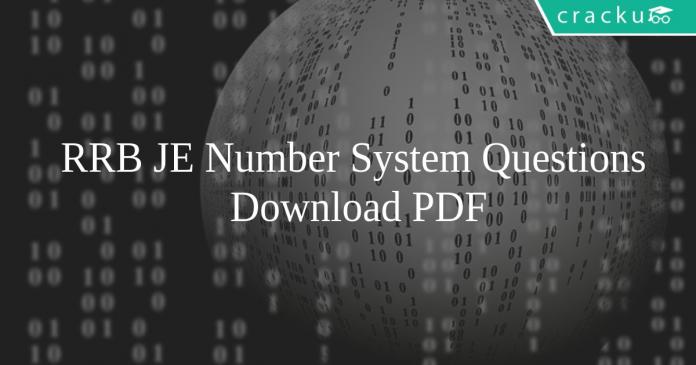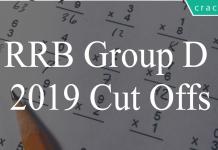RRB JE Number System Questions PDF
Download RRB JE Number System Questions and Answers PDF. Top 25 RRB JE Number System questions based on asked questions in previous exam papers very important for the Railway JE exam.
Download RRB JE Number Systems Questions PDF
10 RRB JE Mocks – Just Rs. 117
RRB JE Previous Papers [Download PDF]

Question 1: The largest 4 digit number that leaves the same remainder when divided by 2, 3, 4 and 5 is
a) 9960
b) 9999
c) 9997
d) 9974
e) 9961
Question 2: If the product of two successive natural numbers is 5402, then find out the sum of the integers.
a) 139
b) 143
c) 135
d) 147
e) None of the above
Question 3: The product of two natural numbers is 9222. If they differ by 19 then find out the sum of the numbers.
a) 205
b) 199
c) 197
d) 195
e) 193

Question 4: What is the remainder when 12345………..404142 is divided by 40?
a) 22
b) 32
c) 18
d) 2
Question 5: What is the ratio of the sum of first 25 odd natural numbers to next 25 odd natural numbers?
a) 1 : 4
b) 2 : 7
c) 1 : 2
d) 2 : 5
e) 1 : 3
Question 6: Find the rightmost non-zero digit in 91!.
Question 7: A 3 digit number becomes a perfect square when divided by 3 and becomes a perfect cube when divided by 2. What is the value of the number?
Question 8: If LCM of two numbers 28!*32! and 30!*31! is $\frac{a!*b!}{c!}$, where a, b (a > b) are two-digit numbers and c is one digit number. Find out the value of a -(b+c)?
Question 9: An antique store has a collection of eight clocks. At a particular moment, the displayed times on seven of the eight clocks were as follows: 1:55 pm, 2:03 pm, 2:11 pm, 2:24 pm, 2:45 pm, 3:19 pm and 4:14 pm. If the displayed times of all eight clocks form a mathematical series, then what was the displayed time on the remaining clock?
a) 1:53 pm
b) 1:58 pm
c) 2:18 pm
d) 3:08 pm
e) 5:08 pm

Question 10: If $a, b, c,$ and $d$ are integers such that $a+b+c+d=30$ then the minimum possible value of $(a – b)^{2} + (a – c)^{2} + (a – d)^{2}$ is
Question 11: Hardik wrote first 215 natural numbers in base 6. How many times did he write ‘4’?
Question 12: Find the number of numbers between 500-700(excluding both) for which the sum of the digit is equal to 9?
a) 10
b) 8
c) 9
d) 12
e) 11
18000+ Questions – Free SSC Study Material
Question 13: Read the following instruction carefully and answer the question that follows:
Expression $\sum_{n=1}^{13}\frac{1}{n}$ can also be written as $\frac{x}{13!}$ What would be the remainder if x is divided by 11?
a) 2
b) 4
c) 7
d) 9
e) None of the above
Question 14: How many subsets of the set {Y,E,A,R,2,0,1,7} are subsets of neither {Y,E,A,R,2} nor {R,2,0,1,7}
Question 15: What will be the remainder when the last two digits of $78^{97}$ is divided by 13?
a) 10
b) 7
c) 5
d) 3
Question 16: Convert 101010101 into decimal system ?
a) 341
b) 431
c) 143
d) 134

Question 17: There are three gongs which strike in the intervals of 3, 4 and 8 minutes. How many times in a day will all three strike together? (All of them start the first strike at 00:00 hours)
a) 61
b) 59
c) 60
d) 48
Question 18: A positive integer ‘k’ is such that 21k is less than $k^2$ by 100. What will be the remainder when k is divided by 7?
a) 4
b) 3
c) 2
d) 0
Question 19: What is the smallest number which when subtracted by 9, is divisible by 14, 16, 18, 21 and 32?
a) 2025
b) 2022
c) 2029
d) 2026
Daily Free Online Tests for RRB Exams

Question 20: Five devices start the first beep together and beep at the intervals of 3, 5, 8, 12, 20 seconds respectively. In first one hour, how many times do they beep together?
a) 31
b) 15
c) 30
d) 16
Question 21: During the school assembly, if the teachers make the students stand in a row of 14 each, 10 students are left. Instead, if they decide to make the students stand in a row of 24 each, 20 students will be left. If they decide to make them stand in rows of 25 each then 21 students will be left. What is the minimum number of students present in the school?
a) 3742
b) 4196
c) 3192
d) 4852
Question 22: Sheela has a certain number of marbles. She notices that she can divide the marbles in groups of 4 but not in groups of 8. She also notices that she can divide the marbles in groups of 5 but not in groups of 15. Which of the following cannot be the number of marbles with Sheela?
a) 100
b) 820
c) 340
d) 720
Question 23: Find the number of odd factors of 2700.
a) 24
b) 16
c) 12
d) 8
Question 24: Find the number of even factors of 1800.
a) 24
b) 27
c) 36
d) 18
Question 25: Find the unit digit of $69^{175}$.
a) 1
b) 3
c) 9
d) 5
General Science Notes for RRB Exams (PDF)

Answers & Solutions:
1) Answer (E)
We know that the number leaves the same remainder when divided by 2,3,4 and 5.
Therefore, the number should be of the form LCM(2,3,4,5) + k.
LCM of 2,3,4,5 is 60.
The largest multiple of 60 below 10,000 is 9960.
2 can leave a remainder of 0 or 1.
Therefore, the largest possible value of k is 1.
The largest 4 digit number that leaves the same remainder when divided by 2, 3, 4 and 5 is 9960 + 1 = 9961.
Therefore, option E is the right answer.
2) Answer (D)
Let ‘$a$’ be the smaller number. Then,
$\Rightarrow$ $a(a+1) = 5402$
$\Rightarrow$ $a^2 + a = 5402$
$\Rightarrow$ $a = 73, -74$
‘$a$’ can’t be -74 as ‘$a$’ is a natural number. Hence, two successive natural numbers are 73 and 74.
Therefore, sum of the numbers = 74 + 73 = 147.
Hence, option D is the correct answer.
3) Answer (E)
Let ‘a’ and ‘b’ be the two numbers where (a > b). It is given that
$\Rightarrow$ a*b = 9222 and a – b = 19
Solving for ‘a’ and ‘b’,
$\Rightarrow$ b(b+19) = 9222, b = 87 or -106
‘b’ can’t be -106 as ‘b’ is a natural number. Therefore, b = 87.
Hence, a = b + 19 = 87 + 19 = 106
Therefore, sum of the numbers = 106 + 87 = 193.
Option E is the correct answer.
4) Answer (A)
To solve this question we will use the Chinese Remainder Theorem.
We split 40 into two factors which are 5 and 8.
On dividing 12345……..404142 by 5, we will get the remainder as 2.
So, 12345……..404142 = 5k + 2 where k is a non-negative integer.
Also, on dividing 12345………404142 by 8, we will get the remainder as 6.
So, 12345……….404142 = 8m + 6 where m is a non-negative integer.
To get the remainder, we will have to find the least value where 5k + 2 and 8m + 6 are equal which is 22.
Therefore, 12345……404142 will leave 22 as the remainder when divided by 40.
Hence, option A is the correct answer.
5) Answer (E)
Sum of first 25 odd natural numbers = 1 + 3 + 5 +… + 49 = $(25)^2$ = 625
Sum of the next 25 odd natural numbers = sum of first 50 odd natural numbers – sum of first 25 odd natural numbers
Sum of the next 25 odd natural numbers = $(50)^2$ – $(25)^2$ = 1875
Hence the required ration = 625 : 1875 = 1 : 3.
Hence, option E is the correct answer.
6) Answer: 2
We know that the rightmost non-zero in x! where 25 < x < 125 = {$4^a$* [Last non-zero digit of a!]*[Last non-zero digit of b!]} mod 10, when we write x as 25a+b.
Here, 91 can be written as 25*3 + 16, therefore, a = 3, b = 16
$\therefore$ The rightmost non-zero in 91! = {$4^3$*[Last non-zero digit of 3!]*[Last non-zero digit of 16!]} mod 10 … (1)
The rightmost non-zero in x! where 5 < x < 25 = {$2^a$* [Last non-zero digit of a!]*[Last non-zero digit of b!]} mod 10, when we write x as 5a+b.
Here, 16 can be written as 5*3 + 1, therefore, a = 3, b = 1
$\therefore$ The rightmost non-zero in 16! = {$2^3$*[Last non-zero digit of 3!]*[Last non-zero digit of 1!]} mod 10 = {8*6*1} mod 10 = 8 … (2)
Substituting the value of the rightmost non-zero in 16! from equation (2) to equation (1),
$\therefore$ The rightmost non-zero in 91! = {64*[6]*[8]} mod 10 = 3072 mod 10 = 2.
7) Answer: 432
The 3 digit number should be of the form $2^a 3^b 5^c ….$ and so on.
We can see that the number becomes a perfect square when divided by 3. Therefore, the power of 3 in the number must be one among 1,3 or 5. ($3^7$ is a four digit number).
The number, on division by 2 becomes a perfect cube. Therefore, the power of 2 can be 1,4 or 7.
Since the number becomes a perfect cube and perfect square on division by 3 and 2, the powers of other numbers should be at least 6.
However, terms such as $5^6$ are huge and hence, we can conclude that the number must be composed of powers of 2 and 3.
’a’ can take values 1, 4 or 7 and ‘b’ can take values 1, 3 or 5.
When divided by 2, the remaining term must be a perfect cube. Therefore, the value of $b$ can only be 3.
When divided by 3, the remaining term must be a perfect square. Therefore, the value of $a$ can only be 4.
Therefore, the number is $2^4*3^3$ = $16*27$ = $432$.
Therefore, $432$ is the right answer.
8) Answer: 0
Let us first calculate HCF of 28!*32! and 30!*31!
$\Rightarrow A = 28! *(32 *31!)$
$\Rightarrow A = 32*28! *31!$ … (1)
$\Rightarrow B = 30!*31!$
$\Rightarrow B = 30*29*28!*31!$ … (2)
From equation 1 and 2 it is clear that HCF = 2*28!*31!
We know that: Product of 2 number = LCM * HCF
$\Rightarrow LCM = \frac{Product of A and B}{HCF of A and B}$
$\Rightarrow LCM = \frac{(28!*32!)*(30!31!)}{2*28!*31!}$
$\Rightarrow LCM = \frac{32!*30!}{2} = \frac{32!*30!}{2!}$
Hence we can say that a = 30, b = 30 and c = 2
Hence a-(b+c) = 32 -(30 +2) = 0 (Answer :0)
9) Answer (B)
Let us find out the difference between the times given to figure out the pattern.
The times given are 1:55 pm, 2:03 pm, 2:11 pm, 2:24 pm, 2:45 pm, 3:19 pm and 4:14 pm.
The difference between 2 consecutive times given are 8 minutes, 8 minutes, 13 minutes, 21 minutes, 34 minutes, and 55 minutes.
We can observe that the difference between the times are in the Fibonacci series.
8 + 13 = 21
21 + 13 = 34
34 + 21 = 55
The Fibonacci series is as follows:
1,1,2,3,5,8,13,21,34,55.
But the first difference in the times given is 8.
Therefore, the missing time must be such that it divides the interval of 8 minutes into 3 minutes and 5 minutes.
The missing time should be 1:58 pm and hence, option B is the right answer.
10) Answer: 2
For the value of given expression to be minimum, the values of $a, b, c$ and $d$ should be as close as possible. 30/4 = 7.5. Since each one of these are integers so values must be 8, 8, 7, 7. On putting these values in the given expression, we get
$(8 – 8)^{2} + (8 – 7)^{2} + (8 – 7)^{2}$
=> 1 + 1 = 2

11) Answer: 108
215 = $ 6^{3} – 1$
Thus 215 is the largest 3 digit number in base 6.
Now we consider all the numbers upto greatest ‘n’ digit number in base 6. Then there will be total $n*6^n$ digits in total.
One-sixth of these digits will be digit ‘4’.
Thus the number of 4’s will be $\frac{n*6^n}{6} = n*6^{n-1}$
Here for 215, n=3 as it is the greatest 3 digit number in base 6.
So number of 4’s are $3*6^2$ = 108
Hence 108 is the right answer.
12) Answer (C)
Three digit numbers starting with 5 whose sum of digits is 9 are 504, 540, 522, 531, 513.
Three digit numbers starting with 6 whose sum of digits is 9 are 603, 630, 612, 621.
Hence there are in total 9 numbers between 500-700 for which sum of the digits is 9.
Hence option C is the correct choice.
13) Answer (D)
Expression : $\sum_{n=1}^{13}\frac{1}{n} = \frac{x}{13!}$
=> $\frac{1}{1} + \frac{1}{2} + \frac{1}{3} + …… + \frac{1}{13} = \frac{x}{13!}$
=> $x = \frac{13!}{1} + \frac{13!}{2} + \frac{13!}{3} + ……… + \frac{13!}{13}$
Now, if $x$ is divided by 11
=> $\frac{13! + \frac{13!}{2} + \frac{13!}{3} + ……… + \frac{13!}{13}}{11}$
All terms are divisible by 11 except $\frac{13!}{11}$
$\therefore$ Remainder if x is divided by 11 = Remainder of $\frac{13!}{11 \times 11}$
= $(10! \times 12 \times 13) \% 11$
= $(10 \times 1 \times 2) \% 11 = 20 \% 11 = 9$
14) Answer: 196
The total number of subsets of the set {Y,E,A,R,2,0,1,7} is $2^8 = 256$
The number of subsets of the set {Y,E,A,R,2} is $2^5=32$ and the number of subsets of the set {R,2,0,1,7} is $2^5=32$
There are two elements common to the sets and the number of number of subsets of the set {R,2} is $2^2=4$
Hence, the total number of subsets of both the sets {Y,E,A,R,2} and {R,2,0,1,7} is $32+32-4=60$
Hence, the required number of subsets is $256-60=196$
15) Answer (A)
Last two digits are nothing but the remainder when the number is divided by 100. In order to find the remainder with 100, we can find the remainder with 25 and 4 and then we can use Chinese remainder theorem.
$78^{97}$ mod 4 = $2^{97}$ mod 4 = 0. Hence the given number will be divisible by 4.
Now
$78^{97}$ mod 25 = $3^{97}$ mod 25
3 and 25 are co-prime. Hence, $3^{20}$ mod 25 = 1 (Euler’s theorem)
=> $(3^{20})^4 * 3^{17}$ mod 25
=> $ 3^{17} \textrm{mod} 25 => (3^3)^5 * 9 \textrm{mod} 25 => 32*9 \textrm{mod} 25 = 7*9 \textrm{mod} 25 = 13$
Hence the resultant remainder will be of the form 25k + 13 and 4m
The only two digit number which fits the relation 25k + 13 = 4m is 88.
When 88 is divided by 13, the required remainder is 10.
16) Answer (A)
$(101010101)_2$
= $1(2^8)+0(2^7)+1(2^6)+0(2^5)+1(2^4)+0(2^3)+1(2^2)+0(2^1)+1(2^0)$
= $256+0+64+0+16+0+4+0+1 = (341)_{10}$
So the answer is option A.
17) Answer (C)
They strike at the intervals of 3, 4 and 8 minutes. They will strike together every 24 minutes (LCM of 3, 4, 8).
In a day, there are 24*60 minutes.
Thus, they will strike together $\frac{24*60}{24} = 60$ times.
18) Answer (A)
We have been given that
$k^2 – 21k = 100$
=> $k^2 – 25k + 4k – 100 = 0$
=> $k(k – 25) + 4(k – 25)$
=> $(k + 4)(k – 25) = 0$
=> k = -4 or k = 25
Since k is positive, so k must be 25.
Hence, the remainder is 4 when it is divided by 7
19) Answer (A)
The required smallest number = LCM(14, 16, 18, 21, 32) + 9 = 2016 + 9 = 2025
Hence, option A is the right answer.
20) Answer (A)
After the first beep together all the 5 devices would beep together next time after LCM(3, 5, 8, 12, 20) seconds.
LCM(3, 5, 8, 12, 20) = 120 seconds or 2 minutes
Number of beeps together in first one hour i.e. 60 minutes = $\frac{60}{2} + 1$ = 31 times
Hence, option A is the right answer.
21) Answer (B)
We can observe that 14 – 10 = 4
24 – 20 = 4
and
25 – 21 = 4
Hence, the required number of students will be nothing but LCM ( 14, 24, 25) – 4
We have
14 = 2*7
24 = 8*3
25 = 5*5
Hence, the required LCM will be 8*25*3*7 = 600*7 = 4200
Hence, the required number of students will be 4200 – 4 = 4196
22) Answer (D)
The number of marbles with Sheela is a multiple of 4 and 5, but are not multiples of 8 and 15. Therefore, the number of marbles must be of the form 20k, where k must neither be even nor must be a multiple of 3.
720 is a multiple of 3. Therefore, the number of marbles with Sheela cannot be 720. Hence, option D is the right answer.
23) Answer (C)
We can factorize the number in form of prime factors.
$2700 = 2^2*3^3*5^2$
Therefore, the number of odd factors = (1)*(3+1)*(2+1) = 12. Hence, option C is the correct answer.
24) Answer (B)
We can factorize the number in form of prime factors.
$1800 = 2^3*3^2*5^2$
Therefore, the number of even factors = (3)*(2+1)*(2+1) = 27. Hence, option B is the correct answer.
25) Answer (C)
We can see that
$9^1$ = 9
$9^2$ = 81
$9^3$ = 729
We can see that the unit digit gets repeated after 2 terms. Therefore, cyclicity of 9 = 2
Hence, we can say that unit digit of $69^{175}$ = unit digit of $69^{174+1}$ = unit digit of $69^1$ = 9
Therefore, option C is the correct answer.
DOWNLOAD APP FOR RRB FREE MOCKS

We hope this Number System Questions for RRB JE Exam will be highly useful for your preparation.





